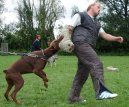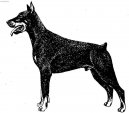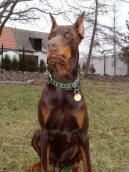Dobermann (Dog standard)
The dobermann is the only german breed which bears the name of its original breeder, friedrich louis dobermann
FCI-Standard N° 143 /14. 02. 1994 / GB
DOBERMANN
TRANSLATION : Dobermann Council of K.U.S.A. (Kennel Union of Southern Africa).
ORIGIN : Germany.
DATE OF PUBLICATION OF THE ORIGINAL VALID STANDARD : 14.02.1994.
UTILIZATION : Companion, protection and working dog.
CLASSIFICATION F.C.I. : Group 2 Pinscher and Schnauzer
type-Molossian type and
Swiss Mountain and Cattle
Dogs.
Section 1 Pinscher and Schnauzer
type.
With working trial.
BRIEF HISTORICAL SUMMARY : The Dobermann is the only German breed which bears the name of its ORIGINal breeder, Friedrich Louis Dobermann (02.01.1834 – 09.06.1894).
He was believed to be a tax collector, offal abbatoir manager (knacker) and a part time dog catcher, legally able to catch all stray dogs. He bred with animals from this reservoir that were particularly sharp. The so called “butcher’s dogs” which were already considered a relatively pure breed at that time, played a most important role in the ORIGINation of the Dobermann breed. These dogs were an early type of Rottweiler, mixed with a type of shepherd which existed in “Thüringen” as a black dog with rust red markings. Herr Dobermann bred with this mixture of dogs in the Eighteen Seventies. Thus he obtained “his breed” : not only alert, but highly protective working and housedogs. They were often used as guard and police dogs. Their extensive use in police work led to the nickname “Gendarme dog”. They were used in hunting to control large vermin. In these circumstances it was a matter of course that the Dobermann was recognized officially as a Police Dog by the beginning of the century.
The Dobermann breed requires a medium SIZEd, powerful, muscular dog. Despite his substance he shall be elegant and noble, which will be evident in his BODY line. He must be exceptionally suitable as a companion, protection and working dog and also as a family dog.
GENERAL APPEARANCE : The Dobermann is of medium SIZE, strong and muscularly built. Through the elegant lines of its BODY, its proud stature, and its expression of determination, it conforms to the ideal picture of dog.
IMPORTANT PROPORTIONS : The BODY of the Dobermann appears to be almost square, particularly in males. The length of the BODY measured from the point of the shoulder to the point of the buttock shall not be more than 5% longer than the height from the withers to the ground in males, and 10% in females.
BEHAVIOUR / TEMPERAMENT : The disposition of the Dobermann is friendly and calm; very devoted to the family it loves children. Medium temperament and medium sharpness (alertness) is desired. A medium threshold of irritation is required with a good contact to the owner. Easy to train, The Dobermann enjoys working, and shall have good working ability, courage and hardness. The particular values of self confidence and intrepidness are requied, and also adaptability and attention to fit the social environment.
HEAD
CRANIAL REGION : Strong and in proportion to the BODY. Seen from the top the HEAD is shaped in the form of a blunt wedge. Viewed form the front the crown line shall be almost level and not dropping off to the ears. The muzzle line extends almost straight to the top line of the skull which falls, gently rounded, into the NECK line. The superciliary ridge is well developed without protruding. The foreHEAD furrow is still visible. The occiput shall not be conspicuous. Seen from the front and the top the sides of the HEAD must not bulge. The slight bulge between the rear of the upper jawbone and the cheek bone shall be in harmony with the total length of the HEAD. The HEAD muscles shall be well developed.
Stop : Shall be slight but visibly developed.
FACIAL REGION :
Nose : Nostrils well developed, more broad than round, with large openings without overall protrusion. Black – on black dogs; on brown dogs, corresponding lighter shades.
Muzzle : The muzzle must be in the right proportion with the upper HEAD and must be strongly developed. The muzzle shall have depth. The mouth opening shall be wide, reaching to the molars. A good muzzle width must also be present on the upper and lower incisor area.
Flews : They shall be tight and lie close to the jaw which will ensure a tight closure of the mouth. The pigment of the gum to be dark; on brown dogs a corresponding lighter shade.
Jaws/Teeth : Powerful broad upper and under jaw, scissor bite, 42 teeth correctly placed and normal SIZE.
Eyes : Middle SIZEd, oval and dark in COLOUR. Lighter shades are permitted for brown dogs. Close lying eyelids. Eyelids shall be covered with HAIR. Baldness around the rim of the eye is highly undesirable.
Ears : The ear, which is set high, is carried erect and cropped to a length in proportion to the HEAD. In a country where cropping is not permitted the uncropped ear is equally recognized. (Medium SIZE preferred and with the front edge lying close to the cheeks).
NECK : The NECK must have a good length and be in proportion to the BODY and the HEAD. It is dry and muscular. Its outline rises gradually and is softly curved. Its carriage is upright and shows much nobility.
BODY :
Withers : Shall be pronounced in height and length, especially in males and thereby determine the slope of the topline rising from the croup to the withers.
Back : Short and tight, of good width and well muscled.
Loin : Of good width and well muscled. The bitch can be slightly longer in loin because she requires space for suckling.
Croup : It shall fall slightly, hardly perceptible from sacrum to the root of the TAIL, and appears well rounded, being neither straight nor noticeably sloping, of good width and well muscled.
Chest : Length and depth of chest must be in the right proportion to the BODY length. The depth with slightly arched ribs should be approximately 50% the height of the dog at the withers. The chest has got a good width with especially well developed forechest.
Underline and Belly : From the bottom of the breastbone to the pelvis the underline is noticeably tucked up.
TAIL : It is high set and docked short whereby approximately two TAIL vertebrae remain visible. In countries where docking is legally not permitted the TAIL may remain natural.
LIMBS
FOREQUARTERS :
General : The front legs as seen from all sides are almost straight, vertical to the ground and strongly developed.
Shoulders : The shoulder-blade lies close against the chest, and both sides of the shoulder-blade edge are well muscled and reach over the top of the thoracic vertebra, slanting as much as possible and well set back. The angle to the horizontal is approximately 50%.
Upper arm : Good length, well muscled, the angle to the shoulder-blade is approximately 105° to 110°.
Elbow : Close in, not turned out.
Lower arm : Strong and straight. Well muscled. Length in harmony with the whole BODY.
Carpus (Carpal joint) : Strong.
Metacarpus (Pastern) : Bones strong. Straight seen from the front. Seen from the side, only slightly sloping, maximum 10°.
ForeFEET : The FEET are short and tight. The toes are arched towards the top (cat like). Nails short and black.
HINDQUARTERS :
General : Seen from the back the Dobermann looks, because of his well developed pelvic muscles in hips and croup, wide and rounded off. The muscles running from the pelvic towards the upper and lower
thigh result in good width development, as well as in the upper thigh area, in the knee joint area and at the lower thigh. The strong hind legs are straight and stand parallel.
Upper thigh : Good length and width, well muscled. Good angulation to the hip joint. Angulation to the horizontal approximately between 80° to 85°.
Knee : The knee joint is strong and is formed by the upper and lower thigh as well as the knee cap. The knee angulation is approximately 130°.
Lower thigh : Medium length and in harmony with the total length of the hindquarter.
Hock joint : Medium strength and parallel. The lower thigh bone is joined to the metatarsal at the hock joint (angle about 140°).
Metatarsus (Rear pastern) : It is short and stands vertical to the ground.
Hind FEET : Like the front FEET, the toes of the back FEET are short, arched and closed. Nails are short and black.
GAIT / MOVEMENT : The GAIT is of special importance to both the working ability as well as the exterior appearance. The GAIT is elastic, elegant, agile, free and ground covering. The front legs reach out as far as possible. The hind quarter gives far reaching and necessary elastic drive. The front leg of one side and back leg of the other side move forward at the same time. There should be good stability of the back, the ligaments and the joints.
SKIN : The SKIN fits closely all over and is of good pigment.
COAT
HAIR : The HAIR is short, hard and thick. It lies tight and smooth and is equally distributed over the whole surface. UnderCOAT is not allowed.
COLOUR : The COLOUR is black or brown, with rust red clearly defined and clean markings. Markings on the muzzle, as a spot on the cheeks and the top of the eyebrow, on the throat, two spots on the forechest, on the metacarpus, metatarsus and FEET, on the inside of the back thigh, on the arms and below the TAIL.
SIZE AND WEIGHT :
Height at withers : Males : 68 – 72 cm.
Bitches : 63 – 68 cm.
Medium SIZE desirable.
Weight : Males : about 40 – 45 kg.
Bitches : about 32 – 35 kg.
FAULTS : Any departure from the foregoing points should be considered a fault and the seriousness with which the fault should be regarded should be in exact proportion to its degree.
GENERAL APPEARANCE : Reversal of sexual impression; little substance; too light; too heavy; too leggy; weak bones.
HEAD : Too heavy, too narrow, too short, too long, too much or too little stop; Roman nose, bad slope of the top line of the skull; weak underjaw; round or slit eyes; light eye; cheeks too heavy; loose flews; eyes too open or too deepset; ear set too high or too low; open mouth angle.
NECK : Slightly short; too short; loose SKIN around the throat; dewlap; too long (not in harmony); ewe NECK.
BODY : Black not tight; sloping croup; sway back; roach back; insufficient or too much spring of rib; insufficient depth or width of chest; back too long overall; too little forechest; TAIL set too high or too low; too little or too much tuck up.
LIMBS : Too little or too much angulation front or HINDQUARTERS; loose elbow; deviations from the standard position and length of bones and joints; FEET too close together or too wide apart; cow-hocks, spread hocks, close hocks; open or soft paws, crooked toes; pale nails.
COAT : Markings too light or not sharply defined; smudged markings; mask too dark; big black spot on the legs; chest markings hardly visible or too large; HAIR long, soft, curly or dull. Thin COAT; bald patches; large tufts of HAIR particularly on the BODY; visible underCOAT.
Character : Inadequate self confidence; temperament too high; sharpness too high; too high or too low a threshold of irritation.
SIZE : Deviation of SIZE up to two centimetres from the standard should result in a lowering of the quality grading.
GAIT : Wobbly; restricted or stiff GAIT; pacing.
DISQUALIFYING FAULTS :
Character : Fearful, nervous and aggressive animals.
General : Pronounced reversal of sexual impressions.
Eyes : Yellow eyes (bird of prey eye); wall eye.
Dentition : Overshot; level bite; undershot; missing teeth.
COAT : White spots; pronounced long and wavy HAIR; pronounced thin COAT or large bald patches.
SIZE : Dogs which deviate more than two centimetres over or under the standard.
Any dog clearly showing physical or behavioural abnormalities shall be disqualified.
N.B. : Male animals should have two apparently normal testicles fully descended into the scrotum.
Source: FCI >>> |




